France Champagne Champagne
12 iconic cellar masters
The cellar master is the spirit of a House.
He practices the Art of blending, he makes
the wines—and in particular the Cuvée Brut
in respect for the style of the House,
and surreptitiously develops them to adapt
them with current tastes. Winemaking is far
from being his only task; here are the varied
profiles of the 12 experienced professionals
we have met.
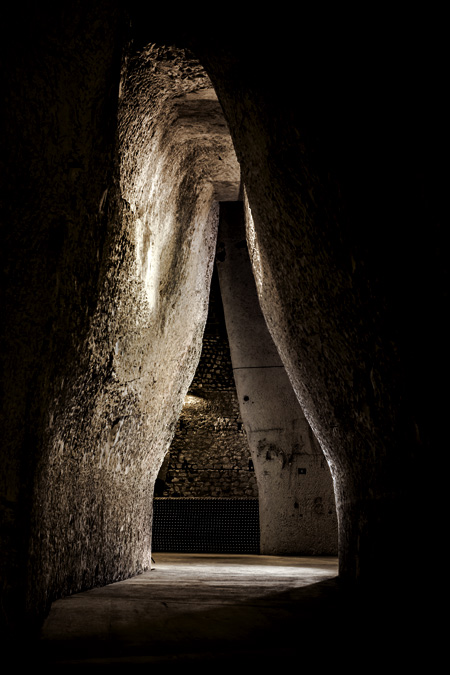
MAISON CHARLES HEIDSIECK
Thierry Roset creates blends of great precision
Born in Sézanne into a family of epicureans, enthusiasts of the very best food and wine, Thierry naturally became a gastronome. As a young man he developed the scientific qualities of curiosity and precision and chose the faculty of oenology in Reims for his vinous education. After an internship at Louis Roederer, a harvest at Moët & Chandon, a temporary position in the production at Charles Heidsieck and several years working at the
Station Œnotechnique in Epernay, in 1988 he was asked by Daniel Thibaut to join him. On the 2nd of September 2013, Thierry celebrated 25 years at Charles Heidsieck; in his turn becoming chief winemaker at the House. This year his first creations are released; his first blends of Brut Réserve and Rosé Réserve, Champagnes of great precision.
“When everything changes it does not interrupt anything”, thinks Thierry Roset. Succeeding Régis Camus, the iconic winemaker still in charge at Piper-Heidsieck, he was promoted to become cellarmaster at Charles Heidsieck and agreed to meet us. Just like the founder, a dandy proud of the quality of his cuvees, this gentleman evokes
“the magic of Champagnes, these living beings with their own personalities”, and creates in our imagination the sudden urge to taste them. Ambonnay produces power, finesse and generosity; Oger such silky texture; Verneuil so food-friendly. Every year he marvels anew as he blends them and lets them develop.
Building on the work of many generations of chief winemaker, the House has developed a style of wines recognisable amongst all: generous, expansive, complex and deep. The blend for Brut Réserve, comprising one third Chardonnay, one third Pinot Noir and one third of Meunier, with 40% of reserve wines, has remained constant through the ages. Thierry brings to this continuity increased precision in the creation. He reduced the number of crus from 120 to 60 (selected for their clear character or promise of long ageing ability) in his first blends which saw the light of day after three years sleeping in the cellars.
He arranged that all the reserve wines kept in stainless steel on fine lees over 10 years were reserved for Champagne Charles Heidsieck so that the average age increased from 8 to 10 years. These wines therefore show more bouquet, linear character, minerality and complexity.
When she arrived, Cécile Bonnefond, President of the Houses of Piper-Heidsieck and Charles Heidsieck (since 2011 part of the Family Group EPI of Christopher Descours), asked all employees of Charles Heidsieck to search for the DNA of the brand. Charles-Camille Heidsieck embodied it; this entrepreneurial wizard never bought a vine but invested in wonderful Gallo-Roman galleries or crayères.
The new Brut Réserve will therefore be packaged in an exclusive bottle named Crayère. Its design reminds us of the architecture of crayère n°9. This is the ultimate gallery in an impressive series of underground cathedrals of great beauty. Here lies buried the treasure including the Brut Réserve which undergoes “a non-negotiable long maturation of three years”, indicates Thierry.
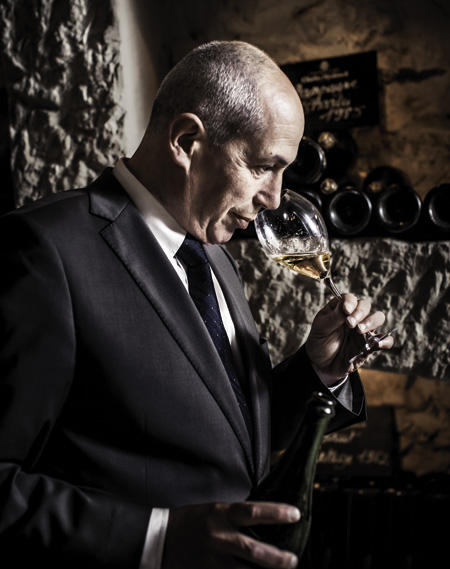
Thierry Roset
For the sake of accuracy, this chief winemaker always puts both the date of bottling and of disgorgement on the back label to inform the consumer. “Henceforth I follow the wines in China as in the United States, in Australia and in Europe, in Italy and in the UK. With all these comments from international tastings the Champagnes of Charles Heidsieck, with their strong personality, represent an open book”.
If this precision does not directly lead to the happiness of the consumer, it certainly helps in highlighting the original character of Rabelais' divine bottle! “Pleasure, according to Jean Anouilh, is it not the only thing which forces us to be precise?”
Marie-Caroline Bourrellis
charlesheidsieck.com
MAISON DEUTZ
Michel Davesne emphasises the importance
of detail for the best results
Born in Sézanne into a farming family,
Michel Davesne took an atypical journey After a high school diploma in sciences, preparatory classes at the
Lycée Clémenceau in Reims, and then the University of Compiègne, he became an engineer in biotechnology. Then followed posts at first Goyard, then at the CIVC*. In 1985, Champagne Palmer took him on as chief winemaker. He learned much at the co-operative, much of the practical part on the job. He passed his Diploma in Oenology, and spent in all some 18 years there. In 2003, aged 45, he joined Champagne Deutz, a much smaller House whose wines he much admired. Today it is he, Michel Davesne who makes them, it is his calling!
He is in charge of the whole production, from the arrival of the grapes to the disgorgement of the finished bottles. Modest by nature, he puts his body and soul into the House, maintaining and improving the style of the wines.
“It is an everyday imperative; I have an obsessional side where quality is concerned. Progress is achieved in a series of small daily steps each important in making progress overall. I am among men who know what will and will not work. I am open to anything that will improve the process.
In 2004 Maison Deutz modernised and expanded production. A new disgorging line increased capacity to 3,000 bottles per hour; and, with the use of jetting** also now incorporated, the wines have improved in consistency. A new fermentation hall has enabled the introduction of new tanks of 100-125 hl, I can make wines village by village and even parcel by parcel across the vineyards owned by Domaine Deutz (42 hectares). In 2011, increased sales required further expansion and the fermentation capacity grew from 17,000 hl to 30,000 hl together with the introduction of further stainless steel vessels which now range from 25 hl to 300 hl. 2013 was a record year, with more than 2 million bottles sold.
I like the houses who are active, who evolve. I have used my attention to detail to drive quality. Thus I adjusted the racking programme to reduce the possibility of the wine coming into contact with oxygen and minimize the risk of oxidation. The new winery has allowed a reduction in the number of wine movements and this has resulted in more purity and precision in the Champagnes. The ageing process however remains traditional, just as was followed by my predecessors. The Deutz style asserts itself through the balance of the three varietals used in the Brut Classic, using wines which are upright, fine, elegant and precise which I don’t touch until March and are bottled in May. 
Michel Davesne au service du Champagne, dans les salons de la Maison Deutz.
Each year, at the moment of blending, I start with a blank piece of paper. We have more material to work with but the foundations remain the same. The President Fabrice Rosset has given me the opportunity to create a NV Brut Rosé which is popular since we are always out of stock at the end of the year. Sourced primarily from Ay, with some other Grands Crus from the Montagne de Reims, this rosé is nearly a Blanc de Noirs, with only 20% Chardonnay, and is neither too heavy nor too vinous.
If I had to go back to the beginning, with no hesitation I would sign again with Deutz, a House which is engaging, with a direction close to the President, where decisions are taken rapidly, where the operations are simple, where communication is direct both with the growers and with the people who work in the business. The family feel is unique, friendly, it encourages you to succeed”.
The final word goes to Leonardo de Vinci, who wrote “details make perfection and perfection is not a detail”!
* Comité Interprofessionnel du Vin de Champagne
** Technique used to prevent oxidation of the wines of Champagne during disgorging. Marie-Caroline Bourrellis
www.champagne-deutz.com MAISON DUVAL-LEROY
Sandrine Logette follows a continuous process of improvement
Born in Reims, daughter of a champenois, oenology graduate of the University of Reims, excelling at maths and science, Sandrine Logette has great credentials. As a result of eating jam and other sweets made by her paternal grandmother and great wines from her mother’s side of the family, she admits to being very fond of good food, especially sweet things. Carol Duval, President of the eponymous House, hired her in 1991
“as quality manager, to set up the department, at the headquarters in Vertus”. This modest and discreet young woman never thought then that she would one day be chief winemaker. In 2005, she was entrusted with the job and in 2007 officially confirmed as chief winemaker at Duval-Leroy.Since then Sandrine has pursued a continuous process of improvement!
“Upon my arrival here in 1991 at Duval-Leroy, at this family House now run by the sixth generation, my first task was to put in place a quality programme. This House is dominated by Chardonnay as it owns 200 ha of vineyards located in the Côte des Blancs, mainly around the villages of Vertus, Sézanne and Vitry, and in addition buys grapes from growers on another 400 ha resulting in a production of around 5 million bottles per year spread across a dozen different styles.
The House had many important clients who asked the President to obtain the quality standard 9002 in the winery. I participated in its implementation. I brought the technique. Together, we built the system for traceability throughout the production of Duval-Leroy. Management systems were established to make sure everything is controlled correctly and today these still rule my life!
At the beginning and at the heart of the new system I improved traceability and quality on the bottling and disgorgement lines. And over fifteen years, through observing the results, I gained the President’s confidence. What has been constructed has required time, the structure is considerable and I have grown along with the House. Having this considerable knowledge gives me the key to running everything well.
I am determined to make everything better. I have innovated in introducing some oak ageing to the Chardonnay, initially into old Burgundy barrels used for the 3rd or 4th time. In 2006, I changed to using new barrels. That was only after three years of research because I don’t want to give too much toasty character to the wine. To increase the frame, the richness and the structure of the Chardonnay I used barrels with a light yet deep toast which makes the wines generous and voluptuous.
In July 2013 I bottled the Femme de Champagne 2012
from a magnificent harvest which will rest in the cellars for ten years before seeing the light of day. I also get good results using small stainless steel tanks to vinify small lots which are then blended with some fermented in barrel. This route has been followed for the Cuvée Femmede Champagne
, the Clos des Bouveries 2005
and the Blanc de Blancs 2002
, which is one of my favourites given its seductive side, elegant, rich and generous, without sugar, really my style of champagne.
In 2008 I designed a barrel cellar and in the winery we brought in small tanks which I had recommended to enable fermentation of small parcels. At Duval-Leroy, because of our high level of hygiene and the sterility of our bottling line we can make up blends with and without malolactic fermentation.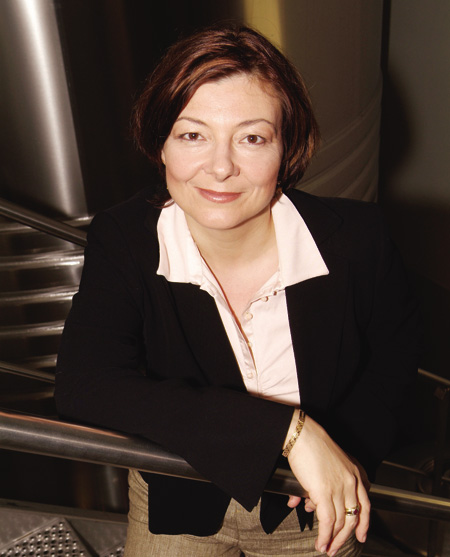
Sandrine Logette, chef de cave de Duval-Leroy, qui a élaboré avec sa présidente Carol Duval le tout nouveau Femme de Champagne Rosé.
I progress step by step, slowly, changing the consumer experience from only drinking Champagne as an aperitif towards enjoyment with food, especially with a meal prepared in fine French style. A meal with champagne leaves you feeling lighter. To get there you need the attack of the wine to be balanced with the roundness which comes from ageing, not from the addition of sugar. I can use lower dosage levels because of what we do earlier in the winery. Each cuvee has a dosage which delivers a clean finish. The Brut 1er Cru was not designed as a wine for food; I have reworked it after discussion, using Pinot Noir from Grand Cru and Premier Cru villages following an approach which delivers a lightness and an accuracy of flavour, with a finish of red fruits and great elegance easily understood by everyone”.
The House of Duval-Leroy is truly creative. Femme de Champagne Rosé de Saignée emerged this autumn, and a new vintage Blanc de Blancs 2006 will be seen at the beginning of 2014. Projects abound in this House. Most are those introduced by Sandrine Logette, a woman of insight and determination!
Marie-Caroline Bourrellis
www.duval-leroy.com MAISON POMMERY
Thierry Gasco develops the creations which become collections
Like father, like son. Bernard Gasco, chief winemaker at Lanson, introduced his son to wine at the age of 8 and passed on his passion for winemaking. Thierry lived through the beginning of the 1960’s, the first stainless steel tanks, use of crown caps, automatic riddling… During the school holidays he helped with samples and followed the results of the analyses. To consolidate this training in the field, he undertook his winemaking studies at Dijon and returned to complete his internship in Champagne. But being unable to find work during the first oil crisis, he took a job in the warehouse at Goulet Turpin en 1975, was made chief winemaker three years later and spent ten years in the world of wine. In 1986, he moved to de Venoge House, and developed the brand and the production system. In 1992, he was called by the House of Pommery. Today he is the oenologist for the group Vranken-Pommery!
The House of Pommery has fascinated him since his arrival by the elegance, finesse and style of the Chardonnay dominated wines; by the extent of the production (6 million bottles); the huge size of the facilities which was in contrast to the tightness of the range. There were only 4 champagnes!
He has known many presidents. Jean-Marie Lefevre drove the House forward. The brand was given colour. At his demand, Thierry Gasco created new products for the seasons: Blanc de Blancs Summertimeand Blanc de Noirs
Wintertime. In 1999 a new challenge presented itself with the launch of the quarter bottle Pop aimed at young people who like their champagne fresh and non-oxidative. He succeeded in transferring the champagne without contact with oxygen under a gas blanket with a new Perrier machine.
In 2002, Paul-François Vranken, the new owner of the House, gave him complete freedom with the wines and autonomy in his actions. He asked him to expand the seasonal range, he created
Springtime, a fresh and sparkling rosé; and Falltime an extra dry Blanc de Blancs.
Popalso became a line with the advent of a rosé
Pink Pop, a vintage Gold Popand finally
Silver Pop. Nathalie Vranken, following the trend towards more sustainable ecological production wants to create an ethical champagne, which will become the flagship of the House in terms of an environmental approach. He created
Earth Pop, product of supervised control, with a lighter bottle, labelled using recycled paper, offered for sale with no extra packaging… a real success.
In 2009,
Apanage Rosé was launched in a special bottle. In 2011 he launched a champagne from the largest single vineyard in Champagne, the
Clos Pompadour, made from the 2002 harvest, available only in magnum, assembled using 75% Chardonnay, 20% Pinot Noir and 5% of Pinot Meunier. Finally his latest creation in 2013 is
Apanage Prestigein a special bottle blended from exclusively Grand Cru wines from the 3 vintages 2004-5-6. What excitement in the creation!
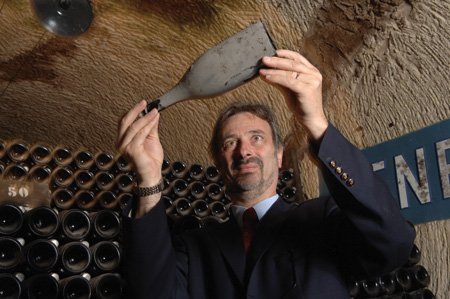
Thierry Gasco dans les caves de la Maison, vérifiant le dépôt dans le col de la bouteille.
“I could express myself through the development of many wines. Each could be seen as the proud birth of a baby. The vintage 2002 is a reference year which affected me the most. In the last decade, 2002 and 2004 seem to be the most interesting. I have always tried to highlight the champagnes, and the wines of the House, matching them with dishes from the top chefs. The President, Paul-François Vranken, offered me the chance to work the oenology across the group which has given me a broader vision of wine.
For four or five years I have been studying how to develop the elaboration of champagne at a technical level, while preserving its characteristics and complexity. Champagne should evolve as other wine regions of the world have done. My pet subject is winemaking and I serve on the Technical Commission of the CIVC, with nine years as chairman of the Œnologues de Champagne, then for six years chairman of the Œnologues de France. During this national chairmanship we managed to get the national diploma in winemaking extended to five years and recognised as a Masters qualification in Europe.”
Hyperactive, Thierry can be proud of his contribution to winemaking in Champagne, but also of his family: his daughter has already graduated in winemaking following in the footsteps of her father and grandfather…
Marie-Caroline Bourrellis
www.vrankenpommery.fr MAISON G.H.MUMM
Didier Mariotti creates emotion and a love of sharing
Youngest amongst the chief winemakers of the Grandes Maisons of Champagne, Didier Mariotti, this forty year old born in Switzerland of a Corsican father and a mother from Burgundy, grew up between Lausanne and Montreux, where he developed the sense of punctuality and a preference for order. He returned to France at the age of 10 and at 20 he joined the Higher Institute of Agronomy in Nancy. He completed an internship at the end of his studies with Moët, then a harvest and year in the winemaking team at Dominique Foulon. He then spent 18 months on voluntary civil national service as a Commercial Attaché in the Economic Expansion Office in New York. Then returning to France he put himself up for his national diploma in Oenology armed with a new internship at Moët. In 1999 he became responsible for the cellars and winemaking at Nicolas Feuillatte.
He joined Mumm in 2003 as assistant to Dominique Demarville, before becoming chief winemaker in 2006, he was then only 35! The House of G.H. Mumm had spotted his precocious talent. Henceforth in command of the blending, his brief was not simply to make the wine. He manages the production, communication with export markets and the future planning for the House, thus there are three extra parts to his responsibilities.
“The heart of the chief winemaker’s job is winemaking, of which 90% is knowledge. But what we cannot learn anywhere is the tasting. You must understand the style of each House. You must bring some complexity to the wine while guarding the elegance and restraint particularly where the signature is of Pinot Noir, the dominant variety used in the champagnes of G.H. Mumm. It must highlight its best expression without bringing too much weight. It is not necessarily achieved with years in the cellar; it is the subtlety of the blend that makes the difference. We are looking for a defined idea, complex with a palate of dried fruits and sweet, nutty overtones.
Champagne is a wine; I am inspired by Burgundy. The art of making a horse trot without it breaking into a gallop only comes with experience. I taste around two thousand samples a year with my team, in order to preserve G.H.Mumm’s style. I am the heir of the House know-how. Brut Cordon Rouge represents 90% of sales and I have changed the style to make it more modern, and with more emphasis on quality, but in a way that has been imperceptible to consumers. The ageing time has increased from 15 to 36 months. The reserve wines in its composition are older, and henceforth represent 30% of the blend.
I am also expected to bring my feelings and my personal touch to the wines. I have great pride in making Cordon Rouge. I have made it with love and passion – feelings and what comes from this are very important to me. Making wines is like being an artist; it is a form of self-discovery, of opening yourself up. I make up the blend according to my instincts, I am always assailed by doubts, constantly questioning and looking for input for solutions. I have developed all the cuvees of the House except the older René Lalou and Verzenay. At the origin of each champagne, there is a love story that begins with the tasting of the still wines, which carries on through the winemaking forward to the revelation in the glass of the consumer”. 
Didier Mariotti
Didier Mariotti travels the world talking about the wines from G.H.Mumm in Japan, as in the UK and in New Zealand where he was going on the evening of our interview. He speaks with emotion, using the founder’s words in offering “only the best”. He reinforces the image of the brand by explaining his priority
“make wines of quality uncompromising in the search for excellence”.He also shares his personal convictions with us:
“I don’t like wines that are expressive immediately upon opening; I prefer to let them show their character and deliver as they open up”. As he explains, he
“educates the market”. The choice of a wine is linked to a moment, a state of mind which can change like the weather. On his desert island he would choose between the Blanc de Blancs Mumm de Cramant and the
Brut Sélection which is made up of 5 different Grand Crus dominated by Pinot Noir blended with reserve wines and aged 5 years in the cellars.
Didier Mariotti is surely an artist, but he is also the production manager. That is a serious job, G.H.Mumm produces 8 million bottles per year, but he is ably supported by an efficient team comprising one hundred people and ten assistants working in the cellars, the production, the winemaking and running the site.
And finally in his diary, some 25% of his time is spent working on forward planning. He finds this area fascinating. Together with his team he plans the evolution of the whole site and its operations, the production capacity and the organisation. He looks into the future to prepare the new product launches to come. But also keeps an eye on the shorter term outlook, reviewing current production to take into account market trends, the effects of global warming and changes in consumption patterns...
What are they?
“I cannot say; that is sensitive information regarding the future of the company!” And the interview in his office adjoining the winery is at an end as he leaves to catch his aeroplane to New Zealand.
Marie-Caroline Bourrellis
www.ghmumm.com
MAISON GOSSET
Jean-Pierre Mareigner takes the measure of time
When he joined Gosset in September 1983, Jean-Pierre Mareigner was following in the footsteps of his father who was, for fifteen years, the vineyard director of this oldest of Houses in Champagne, before he left to run his own vineyards.
Born in Ay in 1956, Jean-Pierre was educated at the Wine High school of Beaune, followed by his military service in Metz as a musician; he plays the saxophone. Returning to Champagne, he worked for two years in the winery at Lanson then with the son of a grower in a family house in the Aube at Riceys, then at Gionges. One day, Paul Varnier, the chief winemaker at Gosset, called him with the news of his own retirement and that he was looking for his successor.
“The House of Gosset is very traditional, with specific vinification (it does not allow any malolactic fermentation) and a definite style on the palate. This Gosset signature has not changed since the beginning; I acquired the fundamentals from Paul. To be sure, in responding to the demands of the market, some cuvees have more Chardonnay to make them better suited to the aperitif but this change is one of nuances, the structure of the wines has been conserved.
This transmission of knowledge, of the secrets of the cellar is vital in maintaining the continuity of style. As a man of the soil, I am very involved with the relationships with our growers, who have supplied us through many generations and have maintained the family relationships so as to closely follow the development of the vines in order to obtain well-formed bunches of beautifully mature grapes.
Flowering finished on 14th July 2013, and then we had 90 to 110 days before the date of the harvest. They started, in the Grande Vallée de la Marne and in the Côte des Blancs, two or three days before the Montagne de Reims because of the topography. The 2013 harvest, if it remains sunny and there is enough water in the ground, looks most promising. In September, at the moment of veraison, we have performed a green harvest to concentrate the flavours. The balance between the acidity and alcoholic potential is crucial”Jean-Pierre acts as a composer, assembling the powerful red notes of a baritone with the crystalline pure white notes of a soprano, to set his cuvees to music. The wines from the 2012 harvest opened out some three weeks later than normal, in February rather than January but he still allowed his “babies” time to grow.
“I take my time; it is the wine that speaks. I have a clean slate to work with because Gosset holds five years of stock on average. No cuvee is released with less than three years in the bottle, the Grande Réserve has five years and the vintage wines are kept for ten. We were able to put the Celebris 1988 into the market ten years late since this wine had very good acidity yet for a long time was quite closed. The vintage 2004 was released before the 2002”.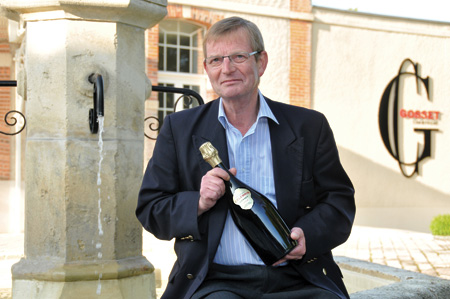
Jean-Pierre Mareigner présentant le nouveau millésime 2002
de la Cuvée Celebris de Gosset.
This sensible man listens to nature and never rushes her. “At the 2013 harvest, I will celebrate 30 years working here. Within the Gosset family I feel good, the balance is harmonious, the production serene. We knew how to respond to a request from customers for a non-vintage Blanc de Blancs. It was created with our President Jean-Pierre Cointreau, without sacrificing the house style. The structure comes from the grapes from the Montagne de Reims, from Villers-Marmerie and Trépail, which were blended with those from the Côte des Blancs. I never tire of this work which demands of us at each harvest how we create a vintage to dream about.”
His favourite? 1952. “I can speak more freely about wines I did not make. It is living history; I can still taste the freshness of the Chardonnay which has evolved buttery and toasty flavours, with aromas of candied lemon and apricots”.
A wine which was judged 2nd in the millennium tasting in 2000, organised by Richard Juhlin. A great result for Champagne Gosset, “A moment that will last in the memory forever” in the words of the novelist Marc Levy!
Marie-Caroline Bourrellis
www.champagne-gosset.com Maison LANSON
Jean-Paul Gandon cultivates the love of his profession
and creates great wines
Born, like Rabelais, in Touraine, the land of easy living, this enthusiast of good living possesses a deep grounding in all the components of the business. Having studied viticulture and winemaking in Burgundy this son of a winemaker left for Algeria on military service where he looked after vineyards and cellars. On his return he set sail for Champagne and was taken on as a winemaker by Rene Lallement in Avize. He progressed, becoming chief winemaker in 1972, responsible for all the Lanson vineyards in 1982 and also for the cellars in 1986. He gained the friendship and confidence of Philippe Baijot, President of Champagne Lanson, who gave him the honour of creating the cuvees to celebrate two hundred and fifty years of the House, three emblematic cuvees in a unique style, baptised with the name
Extra Age!Throughout the Lanson saga, and its changes of ownership, this honest man has always remained faithful to the words of Victor Lanson
“The House of Lanson makes wine in the style originally established in 1760”. To retain the Lanson style, the wines do not undergo the malolactic fermentation because, he explains,
“malic acid is the ideal support for the aromas of fresh fruits”. The flavours of apple, pear and grape are one of the 3 components of the Black Label Brut of Champagne Lanson. The second distinction is their power, their body, their generosity, due to the majority of Pinot Noir in the composition of the blend. The third is their freshness and longevity, deriving from the absence of the malolactic fermentation.
To help appreciate the evolution of the wines, this demanding and perfectionist man puts the disgorgement date on all the Lanson Champagnes. The first age (under 3 years) is the period of fresh fruit and floral notes; the second age (between 3 and 5 years) that of maturity, showing flavours of ripe fruits and warm patisserie; in the third age, that of fullness, the wines develop tertiary aromas and toasted notes. With the mature cuvees, the dosage is low, (3g/l). Very precise, at all the stages of the vinification, Jean-Paul Gandon points out that, with the changes in climate, Champagnes have lost some of their vivacity and tightness and explains that, thirty years ago, the acid level of the wines was normally around 8-9 grams at harvest whereas in the past twenty years it has been more likely to have been between 7 and 8gr/l. 2013, this continental year with the harvest at the end of September brings us back perhaps to something more like those we have known in the past?
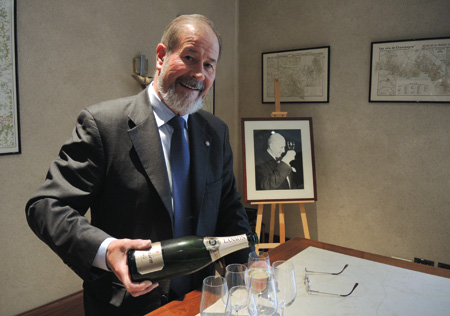
Jean-Paul Gandon, chef de cave de la Maison Lanson,
dirigeant une dégustation au siège.
This happy man, throughout 40 years of experience, has always seen the winds blow favourably for him. And over the years he has developed a great charisma, eloquent in passing on what he knows. The vertical tasting of vintages from 1976 to 1997, which he hosted at Vinexpo, left tasters from the UK and Asia most impressed. He knows so much about his subject and the characteristics of each year which allows him to speak of the wines: “1988 still has much to show us and with its maturity structure and acidity I’d choose a mature Comté to drink it with. It has similarities with 2004, a taut wine with aromatic finesse, to drink at Christmas this year!” The vintage 1976, the oldest of the collection unveiled by the House last year, is a Champagne, says its creator, “to appreciate like an old Cognac by the fireside!”
Great wines never die! Jean-Paul Gandon, can, with great humility, look back with pride on an eventful career that has allowed him to be in the inner circle of decision makers and to create some great wines!
Marie-Caroline Bourrellis
www.lanson.com MAISON MOËT & CHANDON
Benoît Gouez makes innovation the heart of his winemaking
Born in Saint-Lô under the sign of Capricorn, Benoît Gouez grew up in Normandy and only discovered vineyards and wine while studying at the National Institute for Agronomic Research (INRA) in Montpellier. Agronomy meant bringing together scientific and technical skills as well as requiring certain sensitivity. "Nowadays closer association of the scientific and technical in the production process brings good results; but to reach higher you have to add a bit of creativity, he thinks. The other driver for me was the cultural and social aspects of the wine business – also the conviviality. Champagne lends itself to sharing, to a way of life and to travel. Working for Moët & Chandon really motivates me since this moving force in Champagne business is always one step ahead in commercial terms, at the forefront of progress."
“Today, continuing the tradition started at the end of the 18th century through the collaboration of Jean-Remy Moët and researcher Andre Jullien, Moët & Chandon is the only House to employ a research and development team, confirms Benoît Gouez, cellarmaster
. I like to understand things. The word I use most is “why?” I respect tradition but also try to find simplicity and purity in putting the wines together, all the while retaining a generosity of style which also demands precision.
The first stage of vinification is the fermentation. At Moët & Chandon we monitor progress by measuring the release of carbon dioxide and no longer use the traditional specific gravity testing. From taking results every eight hours, we have moved on to five second readings. This constant reaction allows us to be more exact in controlling the process, for example, temperature regulation, oxygen levels and yeast nutrient levels.
The more I learn the more I progress and the more I ask myself questions. However, research and development is not the core of what I do, rather it contributes to our permanent quest for improvement and excellence in the quality of our wines.
My goals, with the support of the whole winemaking team, are to define the quality of the grapes, establish the procedures for the resulting blending, taste all the wines to estimate their profile and potential in order to create the cuvees and finally to bring about the follow-up in the cellar so as to decide on the release of the wines.
I also have to perpetuate the style of Moët Imperial while making sure it continues to evolve. The three principal characteristics of this wine are: brilliant fruit with aromas of citrus fruit, peach and delicate floral notes, evoking a fine terroir and the result of non-oxidative winemaking, delicious on the palate with a charming juicy, full and generous texture, elegance and roundness; an elegant maturity obtained from two years spent in the silence and semi-darkness of our 28km of cellars. Everything starts at the harvest with the definition of maturity of the grapes.”
Maturity of the grapes? Would that be a subjective notion?
“At Moët & Chandon optimum maturity is precisely measured taking into account the richness of the sugar levels and the size of the grapes. We keep track of the sugar content and by following the developmental curve of the grapes over a period of time we can understand how the vine feeds the grapes and anticipate when their growth equals physiological maturity in order to decide the opportune moment for harvesting, according to our objectives for the character profiles of our wines.
Wine is a living thing. The science of wine demands that we are sensitive to this and apply only the best techniques. There is no recipe, every year we question and adapt our winemaking practices. I need information to make the best decisions. The tools and equipment give me indicators but in order to decide the moment of harvest I go out into the vineyard and taste the grapes. Ditto in the blending of Moët Imperial and its 250 cru wines, I reconstruct the cuvee by blind tasting.
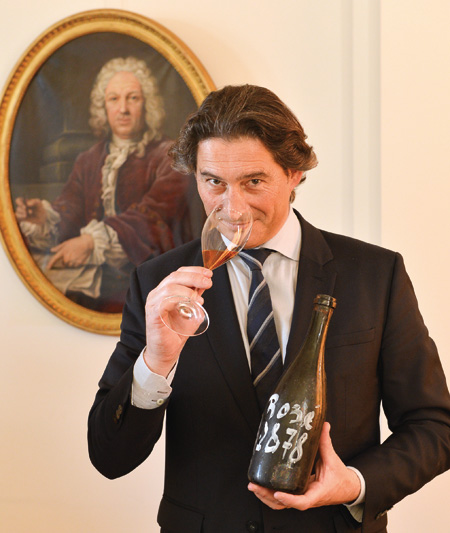
Benoît Gouez
Moët & Chandon has the biggest vineyard holding in Champagne (1150ha, of which half is Grand Cru vineyards and a further 25% Premier Cru). Over and above the quantity, it is the diversity that is a real source of riches. The more I have shades of difference in the grapes, the villages and the vintages while putting together the blend, the more options I have and the more the wines will be on song and the style be respected. Ultimately it is the individual that takes the decisions and blending is linked to tasting in its purest sense.
For Moët Imperial, the blend is always a marriage of the three grape varieties that stand for Champagne. I have at my disposal a great array of Champagne grapes beyond the wildest dreams of any negociant. More than 800 components are required for the consistency of our range. For the blending of the Grand Vintage— apply this to vintage wines which must be the expression of a particular year—I work in a bespoke way, never use the same villages but always pick mature wines which have an obvious potential to age, and consequently I have the freedom to draw out their particular characteristics.”
A disciple of Richard Geoffroy, Benoît Gouez is a strong character, demanding of those around him, a given since he is at the head of Moët & Chandon, yet a creative at heart who stays in control of what he does thanks to his scientific grounding. He leaves an imprint on his work and his signature on his cuvees!
Marie-Caroline Bourrellis
moet.com - www.lvmh.fr
MAISON VEUVE CLICQUOT
Dominique Demarville transfers knowledge
and skill to future generations
He decided, at the age of 18, after working a grape harvest, to make his career in Champagne business. Coming from Sedan in the Ardennes, he had not the faintest idea about production nor about the vineyard.
For his training he followed classes at the Viticampus in Avize and then took off for Dijon to hone his oenological skills and take the national diploma. Curious since a very young age, he then pursued other courses in various wine-growing regions. Falling in love with a girl from Champagne, who later became his wife, brought him back to Champagne, his much preferred terroir.
Several positions with growers and negociants followed until he ended up taking over from Jacques Peters at Champagne Veuve Clicquot. His current role as cellarmaster encompasses a mind firmly occupied in the vineyard while one foot is in the cellars and the other planted in commerce.
He loves being among the vines and finds himself busy with the Veuve Clicquot Domaine comprising 350 hectares of its own land accorded 97% in the Champagne Vineyard Classification and providing 20% of requirements. For the other 80% he tells us that the House has initiated a quality approach with suppliers that which conforms to the CIVC guide to long term viticultural best practice – focussing on organic rather than mineral fertilisation, grassing over and the reduction in the use of insecticides to improve fertilisation...
“There is a dedicated technical team working on this. Since 2007 I have always employed an agronomist, a winemaker and two technicians. Champagne is the finest region for sparkling wines. This is our ancestral reality; our predecessors have always striven to cultivate vines on slopes despite the hostile climate. We are the next stage in all this work. The quality of a wine transfers itself from generation to generation. Without quality grapes there is no chance of quality wine. Equally in the cellar, the transfer of secrets, inherent in our work, is a real source of that rich quality.” Always in the thick of things, Dominique makes good use of his natural interpersonal skills to organise the 40 people that he manages and ensure the drive for perfection. The
Yellow Label Brut is the reflection of the House vineyards and the continuity of a certain style, its calling-card, just as the silk square is to Hermes.
“The dominance of Pinot Noir brings a fruit-filled bouquet, power and substance, also a note of biscuitiness. Chardonnay gives finesse and elegance, while a touch of Pinot Meunier lends an attractive roundness. Sommeliers are appreciative of the Yellow Label's consistent quality – guaranteed through the blending of around hundred crus, vinified by parcels and kept in 500 vats to develop; and also by the addition of 20-40% of reserve wines depending on the vintage, from an extraordinary collection.
At Veuve Clicquot the reserve wines are taken from the 17 different vintages from 1988 to 2012. All of these wines are tasted twice in order to best understand them and decide the most opportune moment to include them. Finally, after some testing, the dosage syrup is added. The 2004 Vintage Veuve Clicquot was a velvety 7g/l, the Yellow Label Brut requires more like 9g/l. The dosage completes the obvious pleasure and balance of the wine.” 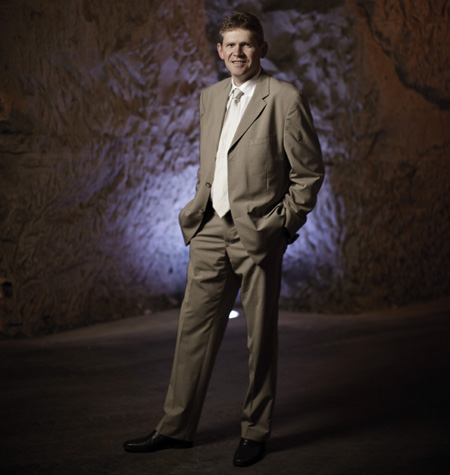
Dominique Demarville dans les crayères de la Maison Veuve Clicquot.
It should be noted that Veuve Clicquot is also the “House of Rosé”, with a historic tradition dating back to 1775 and a range comprising 4 successful labels. The Rosé blend is based on that of the Yellow Label with the addition of high quality red wine produced from attractively mature grapes with strong concentration of fruit from 30 year old vines. The colour of the Rosé, its definition, stability and continuity of style is currently under research at Veuve Clicquot in conjunction with the Oenology department of the University of Reims.
Third string to his cellarmaster's bow: international communication. Dominique is the ambassador for Veuve Clicquot alongside its President, Jean-Marc Lacave. Born under Gemini, he has a natural ease of expression and, with his youthful spirit, he can simply and clearly talk about the Champagnes. Recently he has been to New York, London, and Tokyo in October, to lead tastings and communicate the House style.
He also particularly enjoys food and wine pairing with Joël Robuchon, the world's most Michelin-starred chef who serves magnums of Yellow Label and Rosé NV by the glass, and educates the chefs of Veuve Clicquot's own Hotel du Marc. His dream? That Joël could invent the perfect dish to go with the Yellow Label. To be continued...
Marie-Caroline Bourrellis
www.veuve-clicquot.com MAISON POL ROGER
Dominique Petit, production creator, director and moderniser
The Petit family of Verzy is a proper dynasty of wine growers. Dominique, son of Raymond, grandson of Désiré and great grandson of Achille, is proud of his origins. Throughout childhood every spare moment was spent tying, pruning and hoeing the base of the vines to get rid of bindweed. He even knows how to graft and has the certificate to prove it (courtesy of the Winegrowers of Champagne).
After schooling in Beaune and Avize, he obtained his oenologist's diploma and grounding in the science most useful to him today. For 20 years, from 1979-1999, he worked in Reims for Krug during the time that the company was still family-owned under the successive leadership of Henri and Remy. In 1999 he came to Champagne Pol Roger, another family-controlled house based in Epernay and run by the successors of the eponymous Pol Roger (the de Billy and Pol Roger families).
“These two houses had a common belief: only produce the best! If a wine turned out to be less than the very top quality, my task was to distance myself from it without hesitation."On the 4th September 2013, Dominique welcomed us to the private house belonging to Pol Roger, with its polished panelling and inlaid furniture, its lustrous bronzes and upholstered footstools. He humbly sums up his job in three points. He puts together the wines. Champagne Pol Roger produces a million and a half fine quality bottles. The wines have an assured style which marries balance, fullness and freshness. To accentuate these traits, Dominique has spent twelve years undertaking significant improvements to the vat room and has greatly enlarged the cellar space for settling, blending and vinification.
For the creation or 'elaboration' of his wines, he persuaded his management to introduce small volume tanks of 20 – 160 hectolitres which have allowed him bre









